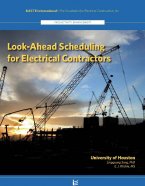Effective Look-ahead Scheduling for Electrical Contractors
Productivity in the construction industry has lagged and continues to lag other industries. Construction subcontractors and, in particular, electrical contractors, are at high risk of subpar productivity performance and schedule delays due to many unique challenges in the field. More often than not, this subpar performance is a planning issue. Published short-term planning methods, such as Workface Planning, Enhanced Work Packaging, and Last Planner®, which have demonstrated success in other fields of construction, can be used to improve productivity in electrical contracting. In this study, the investigators designed a “best practice” tailored to electrical contracting by combining elements of these methods into an effective field-friendly best practice model. The model was designed on the basis of a literature review and a survey of, and interviews with, electrical contractors.
The survey was designed to identify electrical contractors’ current practices, solicit opinions of best practices to identify gaps between current practices and best practices, and identify the most significant causes of delay so that the best practice could be designed to be most effective in improving project performance. The sixty respondents to the survey represented a broad geographic sample within the U.S. and worked on a wide range of project types. They are mainly managers or owners of medium- to large-sized companies. The survey showed look-ahead scheduling to be widely practiced, although the methods, level of detail, and persons responsible varied by contractor.
A comparison between the survey results and proven planning methods showed several areas of potential improvement. The important elements of these methods were combined into a four-step process designed to be most effective for electrical contractors. The planning steps are:
1. A collaboratively planned, multi-week schedule based on work packages tailored to field operations
2. A weekly work plan including only work packages made fully ready and committed to by the foreman
3. A daily plan providing clear assignments to each worker and serving as the basis for record keeping for process improvement
4. Tracking scheduling effectiveness and performing root cause analysis to eliminate recurring delays and improve schedule reliability.
The best practice model was tested in a case study in a water-treatment plant construction project. Feedback and lessons learned from this pilot study are presented in Chapter 5.
This report describes the research and rationale for the best practice, as well as a detailed description of the method.


